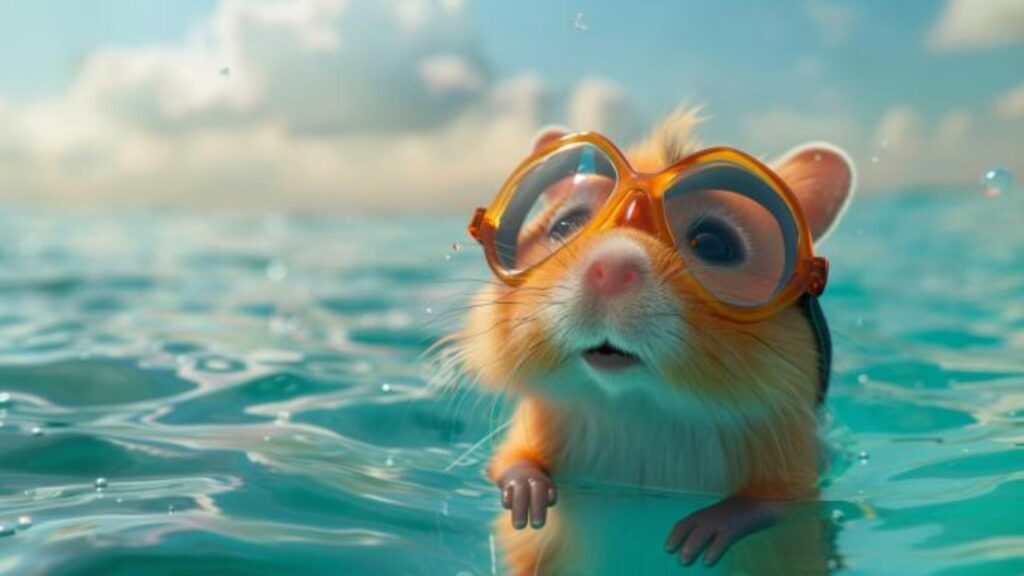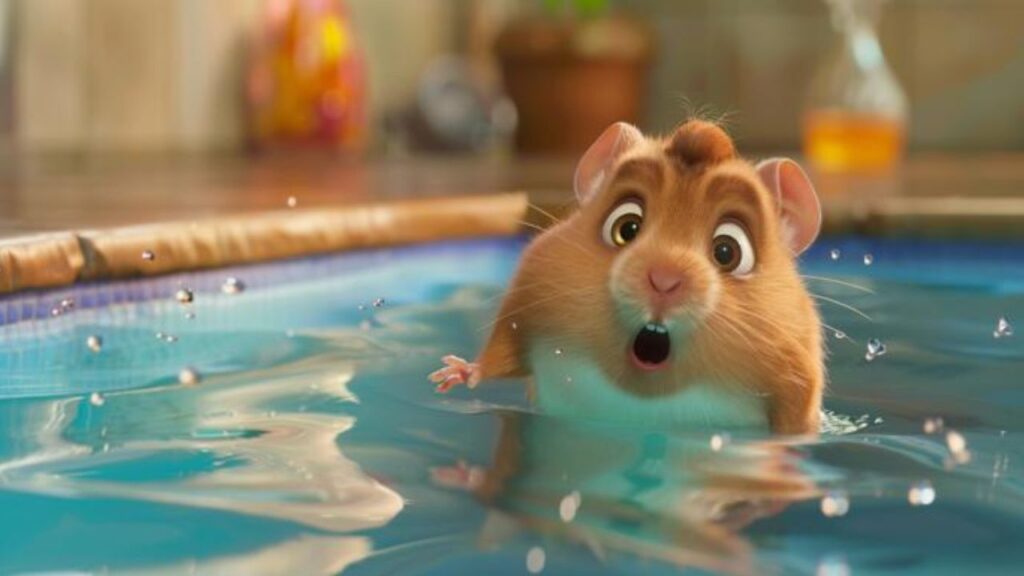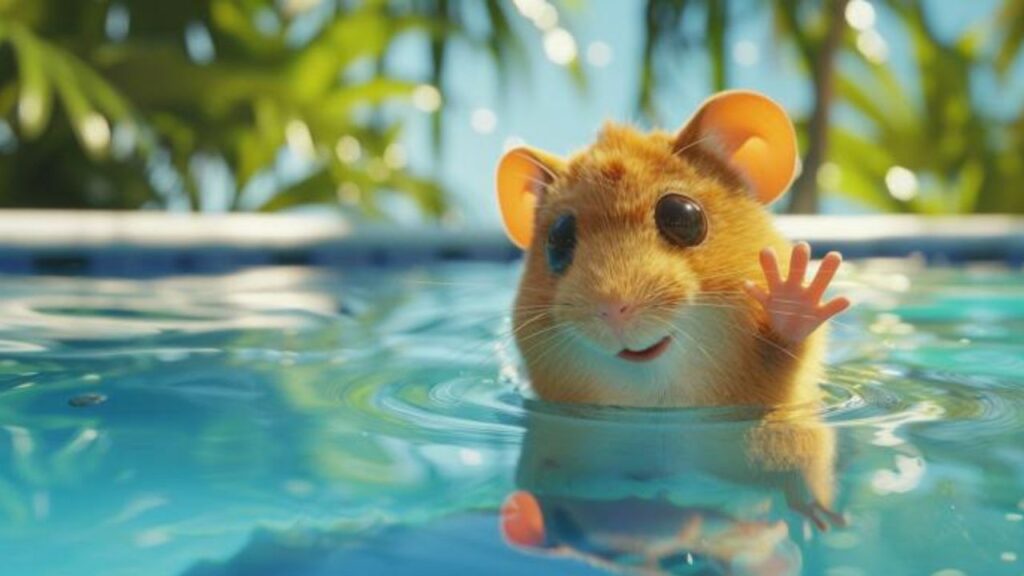TL;DR Summary
No, hamsters should not swim. While they can instinctively paddle in water if necessary, swimming is not a natural or safe activity for them. Hamsters originate from dry areas where swimming isn’t required for survival, and their bodies are not designed for it. Forced swimming can cause significant stress, cold stress, and even trigger diseases like wet tail. Owners should ensure hamsters have shallow water dishes for drinking but avoid any situations where hamsters might be immersed in water. For a happy and healthy pet, keep your hamster dry and provide a safe, enriching environment. Remember, a happy hamster is a wheel-y happy you!
When we think of hamsters, images of these adorable, fluffy creatures scurrying around in their cages or spinning tirelessly on wheels might come to mind. But what about swimming? The question of whether hamsters can swim is not just a curious inquiry—it taps into broader themes about understanding the full range of hamster capabilities and ensuring their care aligns with their natural behaviors and needs. This introduction will explore why grasping these aspects is crucial for any responsible hamster owner.
Importance of Understanding Hamster Capabilities
Knowing what your hamster is capable of doing not only enriches your understanding of these fascinating creatures but also enhances your ability to care for them properly. For instance, if hamsters were capable swimmers, this would influence habitat design and care routines. However, misconceptions can lead to practices that may inadvertently harm your pet.
Importance of Proper Hamster Care
Appropriate care stems from a deep understanding of a hamster’s physiological and psychological needs. Since hamsters are often chosen as pets for children, their care is sometimes oversimplified, which can lead to harmful mistakes. Understanding their capabilities, such as their ability (or lack thereof) to swim, directly influences how we set up their living environments and interact with them daily. Thus, exploring whether hamsters can swim isn’t just about satisfying a curiosity—it’s about ensuring they live happy, healthy lives in captivity.
Hamster Physiology and Natural Habitat

Hamsters are small rodents, but their specific physical traits and the natural environments from which they originate play crucial roles in determining their activities and behaviors, including whether they can swim.
Overview of Hamster Physical Characteristics Relevant to Swimming
Hamsters are characterized by their compact, stocky bodies, short limbs, and dense fur—features that are ideal for their primary natural activity: burrowing. Their physical form is not conducive to swimming. For instance, their short limbs provide poor propulsion compared to the webbed feet of aquatic or semi-aquatic animals, making swimming inefficient and energetically costly for them. Additionally, hamsters have a high surface area to volume ratio due to their small size, which can make them lose body heat quickly in water, risking hypothermia.
Exploration of Their Natural Environments and Behaviors
Hamsters originate from dry, arid regions such as Syria and parts of eastern Europe and Asia, including the deserts of northern China and Mongolia. These areas offer harsh landscapes with extreme temperatures and minimal water bodies, which means hamsters have evolved to conserve water and cope with limited moisture availability.
Their natural behaviors are adapted to environments where the ability to burrow and hide from predators is far more valuable than the ability to swim. In their native habitats, encountering significant bodies of water is rare, and thus, swimming has never been a necessary skill for survival. This background helps explain why hamsters show no inherent inclination towards swimming and why water exposure should be carefully managed to avoid stress or health issues in domestic settings.
Can Hamsters Swim? Analyzing the Facts

The question of whether hamsters can swim touches on more than just curiosity—it’s about understanding a fundamental aspect of their capabilities and how they interact with their environment. This section delves into the natural swimming ability of hamsters and reviews scientific studies and observations to provide a comprehensive look at this topic.
Discussion on the Natural Swimming Ability of Hamsters
While hamsters are not natural swimmers, in extreme situations, they can exhibit a basic paddling behavior similar to the dog paddle. This ability is not an indication of proficiency or comfort in the water but rather a survival instinct. Hamsters’ bodies are not designed for swimming; their movements in water are often awkward and can lead to quick exhaustion. Additionally, their fur is not water-resistant, which means it becomes heavy and sodden when wet, further hindering their ability to swim effectively.
Review of Scientific Studies and Observations Regarding Hamsters in Water
Scientific studies provide insight into the physiological and psychological responses of hamsters to water. One pivotal study involves the use of the Forced Swim Test (FST) in behavioral research, where rodents are placed in a cylinder filled with water from which they cannot escape. It’s important to note that this test is designed to induce a high level of stress and is used to model depression and test antidepressants, rather than to assess natural swimming ability.
Observations from such studies indicate that while hamsters can paddle and keep themselves afloat for a limited time, the experience is highly stressful and can lead to severe stress responses. Prolonged exposure to water in these tests often results in physiological stress markers, including increased corticosterone levels—a hormone associated with stress.
Furthermore, anecdotal observations from pet owners who have mistakenly believed that their hamsters might enjoy a swim have often led to negative outcomes, including stress, illness, and in some cases, fatal consequences. These observations underscore that hamsters do not naturally seek out water and do poorly when forced to swim.
Combining scientific research with practical observations makes it clear that swimming is not a suitable activity for hamsters and can be detrimental to their well-being. This analysis helps hamster owners understand the risks involved and guides them in providing a safer, more comfortable environment for their pets.
Risks Associated with Hamsters and Water

Although hamsters can exhibit basic swimming behaviors in emergency situations, it is crucial to understand that these instances are not only unnatural but also potentially dangerous. This section explores the health risks associated with exposing hamsters to water and the psychological impacts that can result from such experiences.
Health Risks: Cold Stress and Wet Tail
Cold Stress
Hamsters have a high surface area to volume ratio due to their small size, which can lead to rapid heat loss when they are submerged in water. This rapid temperature change can cause cold stress, a condition where the hamster’s body temperature drops to dangerously low levels, impairing their physiological functions. Symptoms of cold stress include lethargy, shivering, and in severe cases, hypothermia, which can be fatal if not promptly addressed.
Wet Tail
Another significant health risk associated with water exposure is wet tail, a colloquial term used to describe proliferative ileitis, a serious gastrointestinal disease in hamsters that is often stress-induced. Wet tail is characterized by severe diarrhea, which can lead to dehydration, and if left untreated, can be fatal within days. The stress of an uncomfortable and unnatural situation like swimming can trigger this condition, especially in younger hamsters.
Psychological Impact of Forced Swimming
The psychological effects of forcing hamsters to swim can be profoundly negative. Hamsters are naturally terrestrial and prefer to keep their fur dry. Being in water can trigger an acute stress response, manifesting as panic and frantic attempts to escape, which can lead to exhaustion or drowning.
Stress Response
Scientific observations, including those from the Forced Swim Test (FST), have shown that hamsters placed in water exhibit signs of acute stress, such as increased secretion of stress hormones like corticosterone. This hormonal spike can have long-term adverse effects on their health, including immune suppression and behavioral changes.
Behavioral Changes
Chronic stress from repeated water exposure can lead to long-lasting behavioral changes in hamsters. These may include increased anxiety, reduced exploration, and changes in eating and grooming habits, all of which significantly diminish their quality of life.
In summary, introducing hamsters to swimming environments, whether intentionally or by accident, can lead to serious physical and psychological distress. Understanding these risks helps hamster owners make informed decisions about their pet care practices, ensuring their hamsters remain safe, healthy, and happy in an appropriate habitat.
Whisker Tips: Safe Practices for Hamster and Water Interaction

While hamsters and large bodies of water don’t mix well, it’s essential to understand how to safely manage their interaction with water in their daily care. This section provides practical advice to ensure that your hamster remains healthy and stress-free when it comes to water exposure.
Practical Advice for Water Bowls and Bathing
Water Bowls
Ensuring your hamster has access to clean, fresh water without risk of drowning is crucial. Here are some tips for safe water bowl usage:
- Shallow Bowls: Use shallow water bowls that are easy for your hamster to access without the risk of falling in. The water level should be low enough to prevent accidental submersion, but sufficient for drinking.
- Stable Design: Opt for a heavy, stable bowl that cannot be easily tipped over by your hamster’s activities. Ceramic dishes are excellent for this purpose.
- Regular Cleaning: Change the water daily and clean the bowl to prevent the buildup of bacteria and ensure hygiene.
Bathing
Hamsters should not be bathed in water. Instead, they clean themselves thoroughly and should remain dry to avoid health issues. If your hamster becomes dirty:
- Spot Cleaning: Use a damp cloth to gently wipe the affected area.
- Sand Bath: Provide a shallow dish filled with chinchilla sand (not dust), which helps hamsters clean their fur naturally without the risks associated with water.
Tips on Creating a Safe and Stress-Free Environment
Cage Placement
Keep your hamster’s cage in a location that maintains a stable temperature and is free from dampness, drafts, and direct sunlight. This helps prevent conditions that could lead your hamster to seek out water excessively due to overheating or other discomforts.
Environmental Enrichment
Provide plenty of environmental enrichment such as tunnels, chew toys, and nesting materials. These not only keep your hamster engaged and happy but also reduce the stress that could be exacerbated by improper exposure to water.
Observation
Regularly observe your hamster for any signs of stress or illness. Quick action can prevent minor issues from becoming severe, ensuring your hamster’s health and happiness.
By following these “Whisker Tips,” you can ensure that your hamster enjoys a safe, comfortable, and dry environment. Maintaining proper care routines minimizes stress and promotes a healthy life for your furry friend, making your relationship a joyful and rewarding experience.
Conclusion

Throughout this exploration of hamsters and their relationship with water, we’ve uncovered several critical insights. While hamsters possess a basic instinct to paddle if placed in water, this ability does not imply proficiency or enjoyment in swimming. The natural physiology and behavior of hamsters show that they are not adapted for aquatic environments, and the potential risks associated with water exposure—such as cold stress, wet tail, and psychological distress—are significant. These findings emphasize the importance of keeping hamster interactions with water to a minimum and managing their environments to suit their natural needs.
Final Thoughts on Keeping Hamsters Safe from Water-Related Hazards
As hamster owners, it is our responsibility to provide a habitat that respects and enhances our pets’ well-being. Understanding that water poses more dangers than benefits to hamsters helps us make informed decisions about their care. By avoiding unnecessary water exposure and focusing on providing a secure, enriching, and appropriate environment, we ensure our hamsters lead happy and healthy lives.
Signature Closing
Ensuring the safety and happiness of your hamster involves more than just providing food and shelter; it’s about creating an environment that aligns with their natural habits and protects them from harm. By keeping your hamster dry and stress-free, you contribute significantly to their overall well-being. Remember, a happy hamster is a wheel-y happy you!




